
About 18 months ago, a fuzzy picture dropped into my email showing a rag-tag bunch of men, some clad in only in loincloths and rubber slippers, armed with machetes and muskets, sitting nonchalantly on the remains of an aeroplane wing that had crashed into the mountains that seperate the Anjaw district of Arunachal Pradesh from Burma. The picture was sent by a friend, Kai Friese, who is the editor of the excellent Outlook Traveller magazine. For the past two years, he had been pursuing a story of a World War II airplane crash in the Mishimi Hills and the amazing story of the survivors. The men in the picture were the people from Bhau village, whom we had hired to do a recce to locate the crash. These guys were the sons and grandsons of the people who had rescued the pilots, carrying them literally on their backs to the nearest British outpost, after they crawled into their village, 14 days after the crash. Two months later, Kai and I were in Arunachal for a most excellent adventure. To view photographs of this trip go here
What follows below is Kai's account of the trip that appeared in Outlook magazine
The Horror...
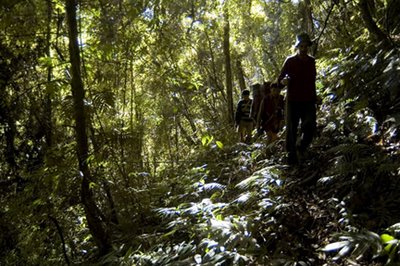 It sounded good in conversation: to walk for a week through the Mishimi Hills in eastern Arunachal Pradesh to the crash site of a China National Aviation Corporation plane, CNAC 58 a Dakota that went down flying 'the Hump' in World War II. Now I'm not so sure. At the end of day one, I'm shaking with exhaustion after bumbling through the undergrowth for eight hours. I've already got lost once in the gloom of the jungle, my right arm is lacerated from clutching at unfriendly plants—still better than falling off the hill. My Mishimi friends are bustling around with depressing energy, fetching water, lighting fires, shooting animals, while I'm listlessly plucking ripe leeches from my ankles. There's a monkey boiling in the pot for dinner and it smells really bad. Adrak kya jaane bandar ka swaad, I quip. Then I taste the damn thing and completely lose my sense of humour.
It sounded good in conversation: to walk for a week through the Mishimi Hills in eastern Arunachal Pradesh to the crash site of a China National Aviation Corporation plane, CNAC 58 a Dakota that went down flying 'the Hump' in World War II. Now I'm not so sure. At the end of day one, I'm shaking with exhaustion after bumbling through the undergrowth for eight hours. I've already got lost once in the gloom of the jungle, my right arm is lacerated from clutching at unfriendly plants—still better than falling off the hill. My Mishimi friends are bustling around with depressing energy, fetching water, lighting fires, shooting animals, while I'm listlessly plucking ripe leeches from my ankles. There's a monkey boiling in the pot for dinner and it smells really bad. Adrak kya jaane bandar ka swaad, I quip. Then I taste the damn thing and completely lose my sense of humour.
By the end of this trip, I will have retched my way through two monkeys, a bear, a mountain goat and an owl. Actually the owl was pretty good. But with 66 leech bites at final count I know I was the tastiest flesh around.
What Am I Doing Here?
I was seduced by geriatrics. It all started three years ago when I spent a night in a Mishimi village called Sarti and an old man called Mun Thalum told me that during the ‘American War’ he saw tamtam garis in the sky long before he ever saw a road vehicle. One plane crashed in the hills of Klong Circle. Two pilots survived and the local villagers carried them back to the plains. A year later, on the internet, I meet Fletcher Hanks, an 85-year-old Hump veteran who photographed the wreck of CNAC 58 from the air in 1944. It went down near the Klong valley and two pilots survived, he tells me. The Mishimis rescued them. Then he talks about the good life and bad death of American mercenary pilots flying CNAC supply planes during the war: "It was a time when sex was safe and flying was dangerous". I’m already in love. Fletcher introduces me to Joe Rosbert, the surviving survivor of CNAC 58. I call Joe and tell him I’d like to meet him. "You better hurry," he says. "I’m 88!"
He’s 89 by the time I catch up with him in a senior citizens’ condominium in Katy, Texas, but he still dreams about the crash that almost ended his young life and the moment, 12 days later, that saved him. "My favourite part is the Mishimis," he says. "I get this picture of Ridge (his co-pilot) down on his knees, and a little further is a bamboo hut. And not only that, in one corner there is smoke, like a chimney. It was a point of salvation." So I go back to the hills to find the people who saved the
 pilots, and in a listing bamboo hut above the gorge of the Klong I am introduced to Mingah Ramat, a beautiful old lady who smokes Janta bidis with all the elegant insouciance of Marlene Dietrich. "Ah, Joe!" she says. "Tell him he should visit me before it’s too late." She imitates the mewling sounds Joe made when he first crawled into her hut, and cackles. Then she draws on her bidi and I can see a nebula of ancient memories flare.
pilots, and in a listing bamboo hut above the gorge of the Klong I am introduced to Mingah Ramat, a beautiful old lady who smokes Janta bidis with all the elegant insouciance of Marlene Dietrich. "Ah, Joe!" she says. "Tell him he should visit me before it’s too late." She imitates the mewling sounds Joe made when he first crawled into her hut, and cackles. Then she draws on her bidi and I can see a nebula of ancient memories flare.Broken English
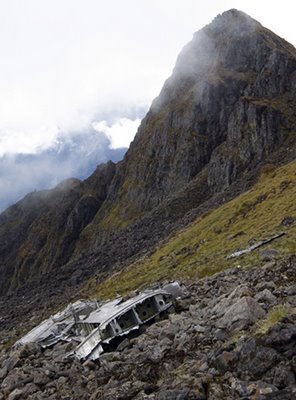
Four excruciating days of climbing, horrible food and one of the worst nights in my life, spooning with my fat friend Harsh in a rain-sodden sleeping bag. And suddenly I’m in heaven. We’re here.
The enormous wing of CNAC 58 is sprawled across a rocky slope beneath the towering tooth of a mountain. Lower down the slope is the tailfin and two sullenly shipwrecked engines. Scattered all around is a mass of debris. Shattered glass, strips of fabric, rusty springs, ornate radio valves, and the doomed cargo of hefty metal pipes. I know we’re not the first people to get here because there’s graffiti on the wing. "Hello from Village Sanglang." "Here came village Bhau." Mishimi as well as Burmese
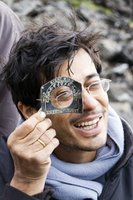 hunters come up here to trap musk deer. The debris field is littered with words that have outlived their purpose. Trademarks, circuit diagrams. A Californian patent, still pending in this remote corner of the Himalaya. There are engraved dials from the instrument panels. Right Wing Aileron Adjust, Manifold Pressure, Inches of Mercury. "DO NOT SET PARKING BRAKE IN FLIGHT," says one long unheeded warning. And then, underneath a rock, I find damp but miraculously preserved strips of newsprint. There isn’t a single complete sentence, just tantalising fragments of headlines, intros, stories. Miss Hepbu... Gish...Artie.... Then I find recipes, "Salt...into... pples...pork...cabbage." I read them greedily. Tonight I will dream of food.
hunters come up here to trap musk deer. The debris field is littered with words that have outlived their purpose. Trademarks, circuit diagrams. A Californian patent, still pending in this remote corner of the Himalaya. There are engraved dials from the instrument panels. Right Wing Aileron Adjust, Manifold Pressure, Inches of Mercury. "DO NOT SET PARKING BRAKE IN FLIGHT," says one long unheeded warning. And then, underneath a rock, I find damp but miraculously preserved strips of newsprint. There isn’t a single complete sentence, just tantalising fragments of headlines, intros, stories. Miss Hepbu... Gish...Artie.... Then I find recipes, "Salt...into... pples...pork...cabbage." I read them greedily. Tonight I will dream of food.Unmissed Calls
Five days later I’m luxuriating in the town of Hayuliang. It’s pronounced ‘Hi Lung’ but the extravagant name translates as "my wine place" and I’m happy to take it literally. We settle into a routine of Godfather beer and Bonnie Scot chasers at Lagan dhaba. There’s cuisine too: alu-puri, paranthas, bhujjia, Maggi.

There’s electricity, a library, broadband internet and, delightfully, no telephones.
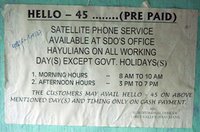 Well there is a phone—the only public telephone in the entire district of Anjaw. An Inmarsat connection in the SDO’s office. It’s popularly called ‘Hello 45’ because by the time you say ‘hello’ the bill is already Rs 45.
Well there is a phone—the only public telephone in the entire district of Anjaw. An Inmarsat connection in the SDO’s office. It’s popularly called ‘Hello 45’ because by the time you say ‘hello’ the bill is already Rs 45.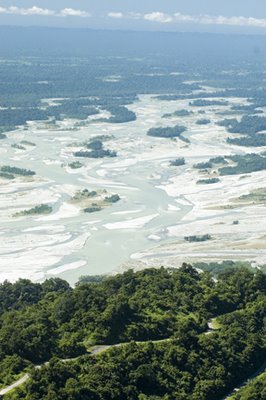
After four days of r&r we head homewards. Cresting the Hawa Pass I sigh with relief at the sight of the effortless plains. But before I know it my head is beeping like a reactivated cellphone. I remember family, friends, and then, The Office. And suddenly I’m in no rush to get home.
4 comments:
Awesome adventure man! Really loved it. I'd want to do one such adventurous trip myself, but I'll make sure that I carry potatoes with me. Can't imagine eating owls, bears and monkeys ;-)
Mrigank V
Hey fatty! Nice to see the pics on the net. Just sent the link to fletcher.
Kai
beautiful pictures. especially the last shot. and some wonderful writing by your friend.
C. Ridgely Hammell III was my brother-in-law. An article about the crash and rescue was published in the Saturday Evening Post in September? of 1944. I have lost the copy of the mag, and his sister, my wife is deceased, but I remember the details of his brief time on this earth.
Post a Comment